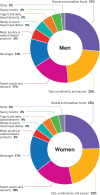Association of ultra-processed food consumption with colorectal cancer risk among men and women: results from three prospective US cohort studies
- PMID: 38752573
- PMCID: PMC9430376
- DOI: 10.1136/bmj-2021-068921
Association of ultra-processed food consumption with colorectal cancer risk among men and women: results from three prospective US cohort studies
Abstract
Objective: To examine the association between consumption of ultra-processed foods and risk of colorectal cancer among men and women from three large prospective cohorts.
Design: Prospective cohort study with dietary intake assessed every four years using food frequency questionnaires.
Setting: Three large US cohorts.
Participants: Men (n= 46 341) from the Health Professionals Follow-up Study (1986-2014) and women (n=159 907) from the Nurses' Health Study (1986-2014; n=67 425) and the Nurses' Health Study II (1991-2015; n=92 482) with valid dietary intake measurement and no cancer diagnosis at baseline.
Main outcome measure: Association between ultra-processed food consumption and risk of colorectal cancer, estimated using time varying Cox proportional hazards regression models adjusted for potential confounding factors.
Results: 3216 cases of colorectal cancer (men, n=1294; women, n=1922) were documented during the 24-28 years of follow-up. Compared with those in the lowest fifth of ultra-processed food consumption, men in the highest fifth of consumption had a 29% higher risk of developing colorectal cancer (hazard ratio for highest versus lowest fifth 1.29, 95% confidence interval 1.08 to 1.53; P for trend=0.01), and the positive association was limited to distal colon cancer (72% increased risk; hazard ratio 1.72, 1.24 to 2.37; P for trend<0.001). These associations remained significant after further adjustment for body mass index or indicators of nutritional quality of the diet (that is, western dietary pattern or dietary quality score). No association was observed between overall ultra-processed food consumption and risk of colorectal cancer among women. Among subgroups of ultra-processed foods, higher consumption of meat/poultry/seafood based ready-to-eat products (hazard ratio for highest versus lowest fifth 1.44, 1.20 to 1.73; P for trend<0.001) and sugar sweetened beverages (1.21, 1.01 to 1.44; P for trend=0.013) among men and ready-to-eat/heat mixed dishes among women (1.17, 1.01 to 1.36; P for trend=0.02) was associated with increased risk of colorectal cancer; yogurt and dairy based desserts were negatively associated with the risk of colorectal cancer among women (hazard ratio 0.83, 0.71 to 0.97; P for trend=0.002).
Conclusions: In the three large prospective cohorts, high consumption of total ultra-processed foods in men and certain subgroups of ultra-processed foods in men and women was associated with an increased risk of colorectal cancer. Further studies are needed to better understand the potential attributes of ultra-processed foods that contribute to colorectal carcinogenesis.
© Author(s) (or their employer(s)) 2019. Re-use permitted under CC BY. No commercial re-use. See rights and permissions. Published by BMJ.
Conflict of interest statement
Competing interests: All authors have completed the ICMJE uniform disclosure form at https://www.icmje.org/disclosure-of-interest/ and declare: support for the submitted work from the National Institutes of Health/National Institute on Minority Health and Health Disparities; no financial relationships with any organizations that might have an interest in the submitted work in the previous three years; no other relationships or activities that could appear to have influenced the submitted work.
Figures

References
LinkOut - more resources
Full Text Sources
